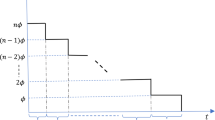Abstract
All non-homogeneous Poisson process (NHPP) software reliability growth models of the finite failures category share the property that every time to failure distribution is defective. The reason for this phenomenon is the fact that according to these models it is always possible that no fault is left in the software. Excluding this possibility leads to a class of infinite failures category NHPP models which we call truncated NHPP models. In this paper, we derive the truncated models connected with three well-known finite failures NHPP models and discuss some of their properties. We then compare the performance of these new models with that of their counterparts.
Similar content being viewed by others
References
Abdel-Ghaly, A.A., Chan, P.Y. and Littlewood, B. (1986). Evaluation of competing software reliability predictions, IEEE Transactions on Software Engineering 12, 950–967.
Akaike, H. (1992). Information theory and an extension of the maximum likelihood principle, In: Kotz, S. and Johnson, N.L. (ed). Breakthroughs in Statistics — Volume I. Springer, New York, 611–624. (Reprint of the original 1973 paper).
Brocklehurst, S. and Littlewood, B. (1996). Techniques for prediction analysis and recalibration, In: Lyu, M.R. (ed), Handbook of Software Reliability Engineering. New York, 119–166.
Data & Analysis Center for Software. The software reliability dataset. Available at http://www.dacs.dtic.mil/databases/sled/swrel.shtml. (Link verified on August 3, 2005).
Goel, A.L. (1985). Software Reliability Models: Assumptions, Limitations and Applicability, IEEE Transactions on Software Engineering 11, 1411–1423.
Goel, A.L. and Okumoto, K. (1979). Time-dependent error-detection model for software reliability and other performance measures, IEEE Transactions on Reliability 28, 206–211.
Grottke, M. and Trivedi, K.S. (2005). On a method for mending time to failure distributions, In: Proceedings of the 2005 International Conference on Dependable Systems and Networks, Los Alamitos, 560–569.
Lyu, M.R. and Nikora, A. (1991). A heuristic approach for software reliability prediction: The equally-weighted linear combination model, In: Proceedings of the 1991 International Symposium on Software Reliability Engineering, Los Alamitos, 172–181.
Musa, J.D., Iannino, A., and Okumoto, K. (1987). Software Reliability — Measurement, Prediction, Application. McGraw-Hill, New York.
Ohba, M. (1984). Software reliability analysis models, IBM Journal of Research and Development 28, 428–443.
Trivedi, K.S. (2001). Probability and Statistics with Reliability, Queuing and Computer Science Applications. John Wiley, New York.
Yamada, S., Ohba, M., and Osaki, S. (1983). S-shaped reliability growth modeling for software error detection, IEEE Transactions on Reliability 32, 475–478.
Author information
Authors and Affiliations
Additional information
This work was supported by a fellowship within the Postdoc Program of the German Academic Exchange Service (DAAD).
Rights and permissions
About this article
Cite this article
Grottke, M., Trivedi, K.S. Truncated Non-homogeneous Poisson Process Models — Properties and Performance. OPSEARCH 42, 310–321 (2005). https://doi.org/10.1007/BF03398742
Published:
Issue Date:
DOI: https://doi.org/10.1007/BF03398742




